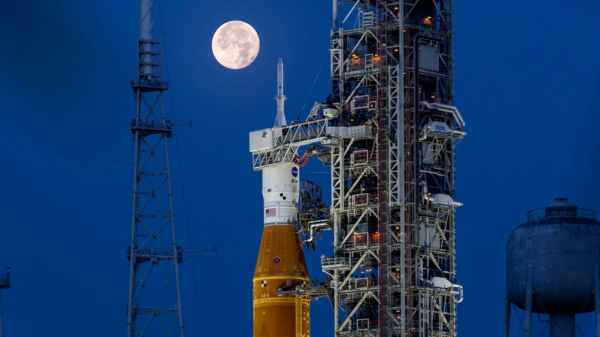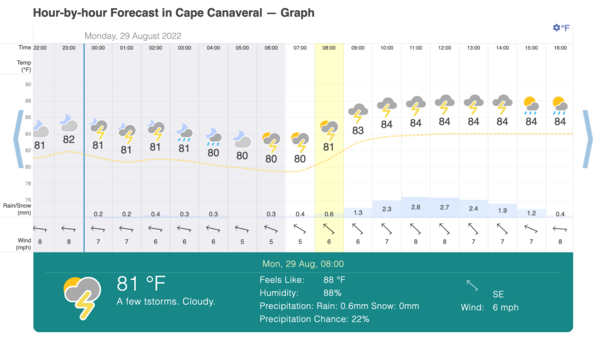Watching the Weather for Artemis I
Stormy weather could delay the launch of NASA’s latest Moon mission on Monday.
UPDATE (September 4)
Good things are worth waiting for: as a result of technical issues on Monday, August 29—and again on Saturday, September 3—Artemis I will not launch until later in September, or October.

Destination Moon: the Artemis I test flight is scheduled to last for 42 days.
©NASA
Heading Back to the Moon
NASA’s Artemis I mission is due to blast off for the Moon this Monday, August 29, 2022.
The uncrewed flight is the first in a series of deep-space missions that are designed to return humans to the Moon in 2025.
Moonrise, moonset, and other Moon tools
Artemis I will launch from Pad 39B at NASA’s Kennedy Space Center in Merritt Island, Florida. A two-hour launch window opens at 08:33 EDT (12:33 UTC).
Countdown to opening of launch window
In Greek mythology, Artemis was Apollo’s twin sister and the goddess of the Moon.
Delays Possible
This is rocket science, and there are countless technical issues that could delay the launch. There is also the weather—did you know that Florida has more frequent lightning and thunderstorms than any other US state?
Check the weather for the launch site
At the moment, the weather forecast for Cape Canaveral on the morning of August 29 suggests that there could be storms. (Cape Canaveral is a launch facility next door to the Kennedy Space Center.)
The following is a list of just some of NASA’s weather guidelines for delaying the launch of Artemis I. Lightning strikes, for example, could damage the rocket’s guidance systems or other electronics.
Temperature
- Do not launch if the temperature at both 132.5 feet and 257.5 feet (40.4 m and 78.5 m) exceeds 94.5 degrees Fahrenheit (34.7 °C) for 30 consecutive minutes.
- Do not launch if the temperature at both 132.5 feet and 257.5 feet (40.4 m and 78.5 m) drops below a defined temperature constraint for 30 consecutive minutes. The temperature constraints range from 38 degrees Fahrenheit to 49 degrees Fahrenheit (3 °C to 9 °C), depending upon the wind and relative humidity.
Wind
- Do not launch if the peak liftoff winds exceed a range of 29 knots through 39 knots (54 kph through 72 kph) between 132.5 feet and 457.5 feet (40.3 m and 139.4 m), respectively.
- Do not launch through upper-level wind conditions that could lead to control problems for the launch vehicle.
Precipitation
- Do not launch through precipitation.

With the warm waters of the Gulf of Mexico to the west, and the Atlantic Ocean to the east, the hot and humid Florida peninsula is the lightning capital of the USA.
©iStockphoto.com/WGCPhotography
Lightning
- Do not launch for 30 minutes after lightning is observed within 10 nautical miles (19 km) of the flight path, unless specified conditions related to cloud distance and surface electrical fields can be met.
- Do not launch if the flight path is within 10 nautical miles (19 km) of the edge of a thunderstorm that is producing lightning until 30 minutes after the last lightning discharge is observed.
Clouds
- Do not launch if the flight path is within 3 nautical miles (6 km) of a thunderstorm debris cloud for 3 hours, unless temperature, surface electric field, and radar reflectivity criteria can be met.
- Do not launch if the flight path is within 5 nautical miles (9 km) of disturbed weather clouds that extend into freezing temperatures and contain moderate or greater precipitation.
- Do not launch if the flight path is within 10 nautical miles (19 km) of cumulus clouds with certain distance and height criteria.
Solar Activity
- Do not launch during active solar activity resulting in increased density of solar energetic particles.
Source: NASA
Forecast for August 29
At the time of publishing this article, the weather forecast for the morning of August 29 is not so good, with thunderstorms being a possibility.


At the moment, the weather forecast for the planned Artemis I launch is a concern—‘tstorms’ means thunderstorms.
©timeanddate